The diesel engines that power most of the world’s heavy-hauling semi-tractors are large, heavy, and complex units. They have countless parts that can go wrong and are often packed into spaces that make them hard to work on. These engines also often return only single-digit fuel economy. Back in the 1950s, Boeing thought it had a solution. It developed the Boeing Gas Turbine Engine, a turbine that was less than 13 percent of the size of a truck diesel, and with far fewer parts. Boeing hoped the engine would revolutionize trucking and maybe even farming. Instead, the idea flopped so hard that few people remember it, and a big part of it was that the truck got a whopping 1 mile per gallon.
The gas turbine has often been seen as a sort of transportation holy grail. In theory, a turbine has a lot going for it. Turbine engines have high power-to-weight ratios and tend to be significantly smaller than a reciprocating engine designed to have the same power output. In theory, this means that the turbine engine will also weigh significantly less than an equivalent reciprocating engine. The potential benefits go even further than that, as turbines have fewer moving parts than reciprocating engines and, when tuned right for the correct application, can return impressive efficiency. In several decades past, it was also believed that turbines were much cleaner for the environment than reciprocating engines.
A modern turbine works by drawing air in through an inlet, where it goes into a compressor, which pressurizes the air using airfoil-shaped spinning blades. That pressurized air is then joined by fuel and is ignited in the combustion chamber and burner. The ignited high-pressure and fast-flowing mixture enters the turbine, which has more airfoil-shaped rotating blades. The mechanical work of the rotating turbine can be used to spin a propeller shaft, driveshaft or generator. The turbine is also connected to the shaft that drives the compressor. A turbofan engine is a type of turbine, and the long shaft containing the turbine and the compressor is capped off with a gigantic fan featuring titanium blades.

That is a simplified version of how turbines work, but I think I got the point across. Turbines are the durable and powerful workhorses of commercial aviation and military aviation, but there have been countless times throughout history when engineers wanted to use the same technology here on the ground. The most famous example of this is the Chrysler Turbine Car. Toyota and Rover also experimented with turbines at different eras of automotive history. General Motors would spend three decades trying to put turbines into everything from transit buses to all kinds of concept cars.
But there was a time when just about everyone had turbine fever. Perhaps the most infamous turbine project was the Union Pacific Gas Turbine-Electric Locomotive. The GTELs were the result of the Union Pacific’s unquenchable thirst for a single locomotive to rule them all. The GTEL was America’s most powerful locomotive, but it was thunderously loud, had exhaust so hot that it cooked birds mid-flight, it melted concrete, and it stopped making sense the second bunker fuel stopped being dirt-cheap.

Turbines also snaked their way into the trucking industry. These engines were touted as putting out tons of performance with fewer moving parts, a lighter weight, great long-term reliability, and maybe even better fuel efficiency. This was catnip for some engineers. A lighter and smaller engine could result in a smaller and lighter truck that carried more weight, which was a huge deal when, in the past, trucks were severely limited in length and weight.The most famous turbine truck projects include the Ford “Big Red,” the GM Bison, and the International TurboStar. Predating all of these trucks is the time when Boeing and Kenworth joined forces in an attempt to create the ultimate truck.

You might wonder why Boeing was trying to make the ultimate truck when its primary focus was aviation. As Popular Mechanics wrote in August 1953, getting into trucking wasn’t Boeing’s original intent. The plane builder began turbine research in 1944 with the initial goal of just exploring the new technology. At that time, Boeing had a jet propulsion laboratory that was only a year old. The U.S. Army was interested in jet power, and Boeing thought that a large jet transport could be successful. However, gas turbines were still an emerging technology, and Boeing wanted to look into that, too.
It wasn’t long into Boeing’s research when its engineers discovered that gas turbines had tons of untapped potential. Gas turbines, Boeing thought, could be used for far more than aviation. A gas turbine could power a small plane or a Navy boat, work as a jet engine starter, or propel a bomb or a missile. The possibilities seemed endless.
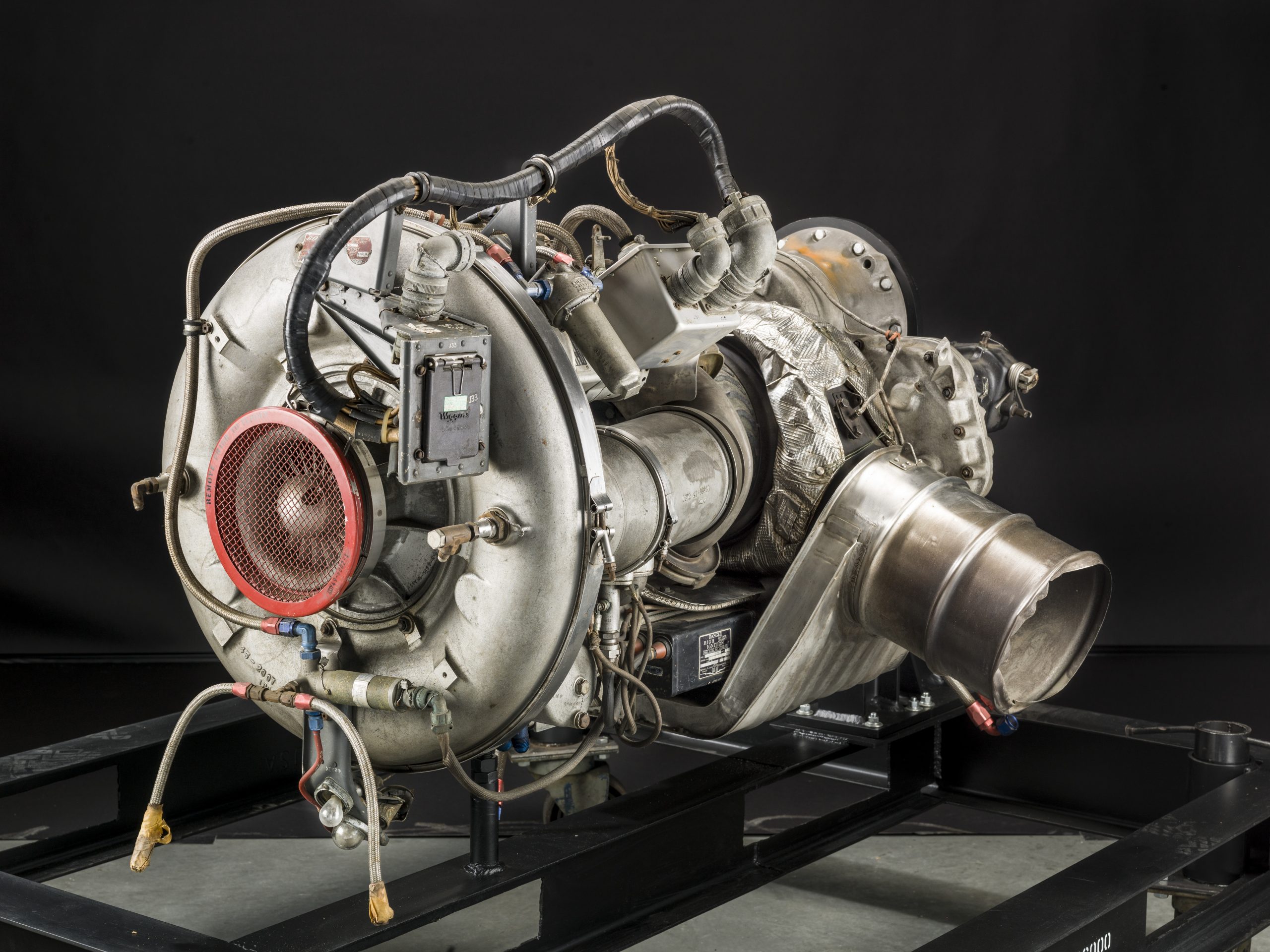
Boeing’s first gas turbine was the Model 500, which came to life for the first time in 1947. The Model 500 was a turbojet that weighed 85 pounds and made 150 pounds of thrust. Boeing marketed this engine, but found no takers. So, its engineers would improve the Model 500 to make more power while also evolving the concept into a turboprop.
The Model 502 first came online in 1947 before going into production in 1949. Instead of using jet blast for thrust, this engine would spin a propeller. The first versions of these engines weighed 140 pounds and made 120 shaft horsepower.

Later in 1949, Boeing hoped to get a contract from the Navy, and sent six of its turbines to live in personnel boats. In late 1951, a Model 502 powered a Kaman K-225, which was the first flight of a gas turbine-powered helicopter. A year later, a Model 502-powered Cessna XL-19B Bird Dog became the first turboprop plane.
But Boeing also recognized that its gas turbines had far more applications than just the ocean and sky. In 1950, Popular Science reported Boeing reached out to Kenworth and suggested that its revolutionary new turbine could lead to innovation in trucking. Kenworth bit, and in that year, Kenworth fitted a 200-pound, 175 HP Boeing Model 502 gas turbine into the engine bay of a Kenworth conventional.
The Turbine Kenworth
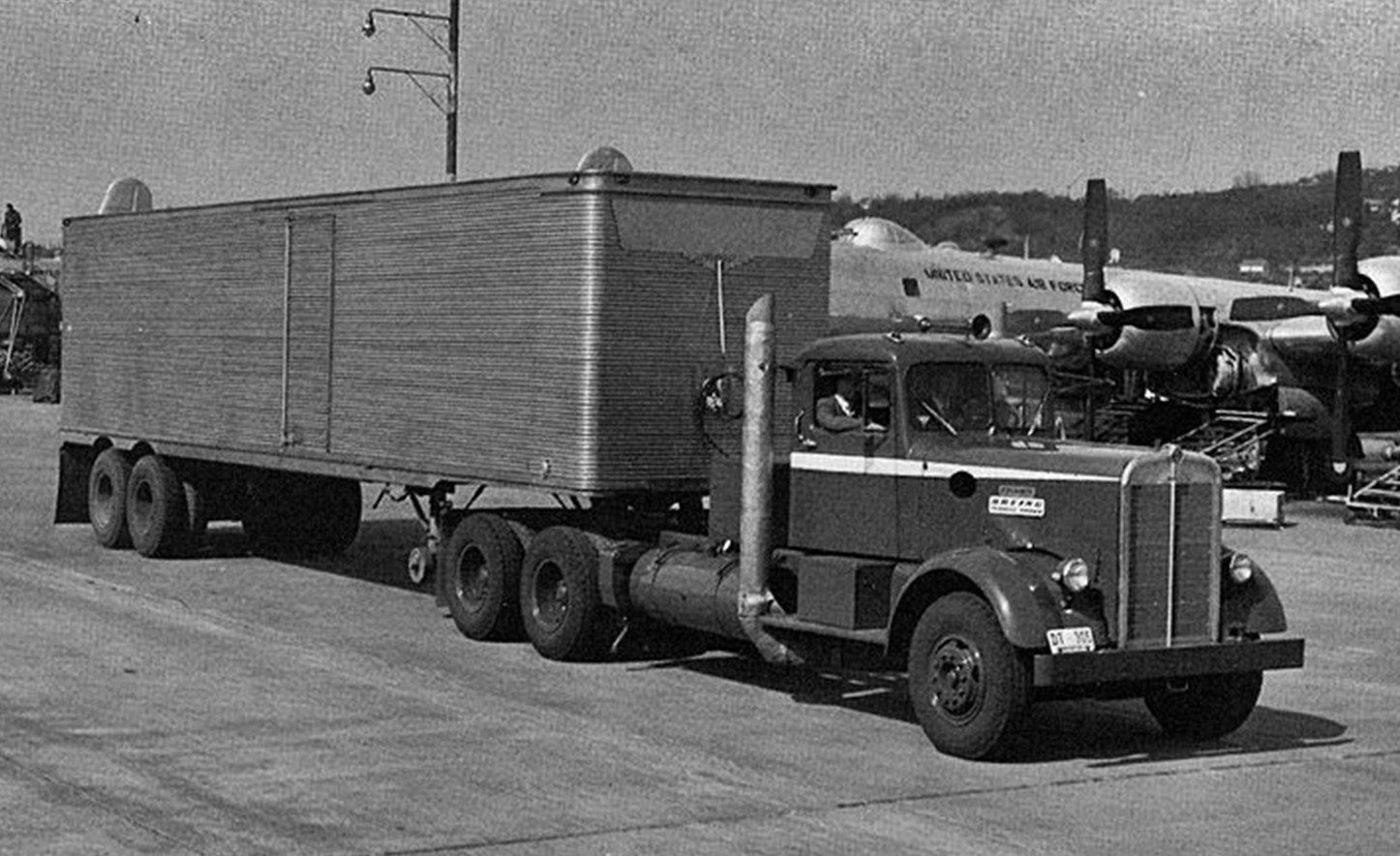
The Boeing and Kenworth partnership seemed like a natural fit. Both companies were in Seattle, and Kenworth even had some aircraft experience after having built B-17s and B-29s during World War II. Kenworth saw the potential advantages of aviation power in trucking.
This truck would grab headlines all over America. Apparently, many of those publications called the Model 502-powered Kenworth a jet-powered truck, but that’s not true. The engine that powered the truck turned a rotating shaft.
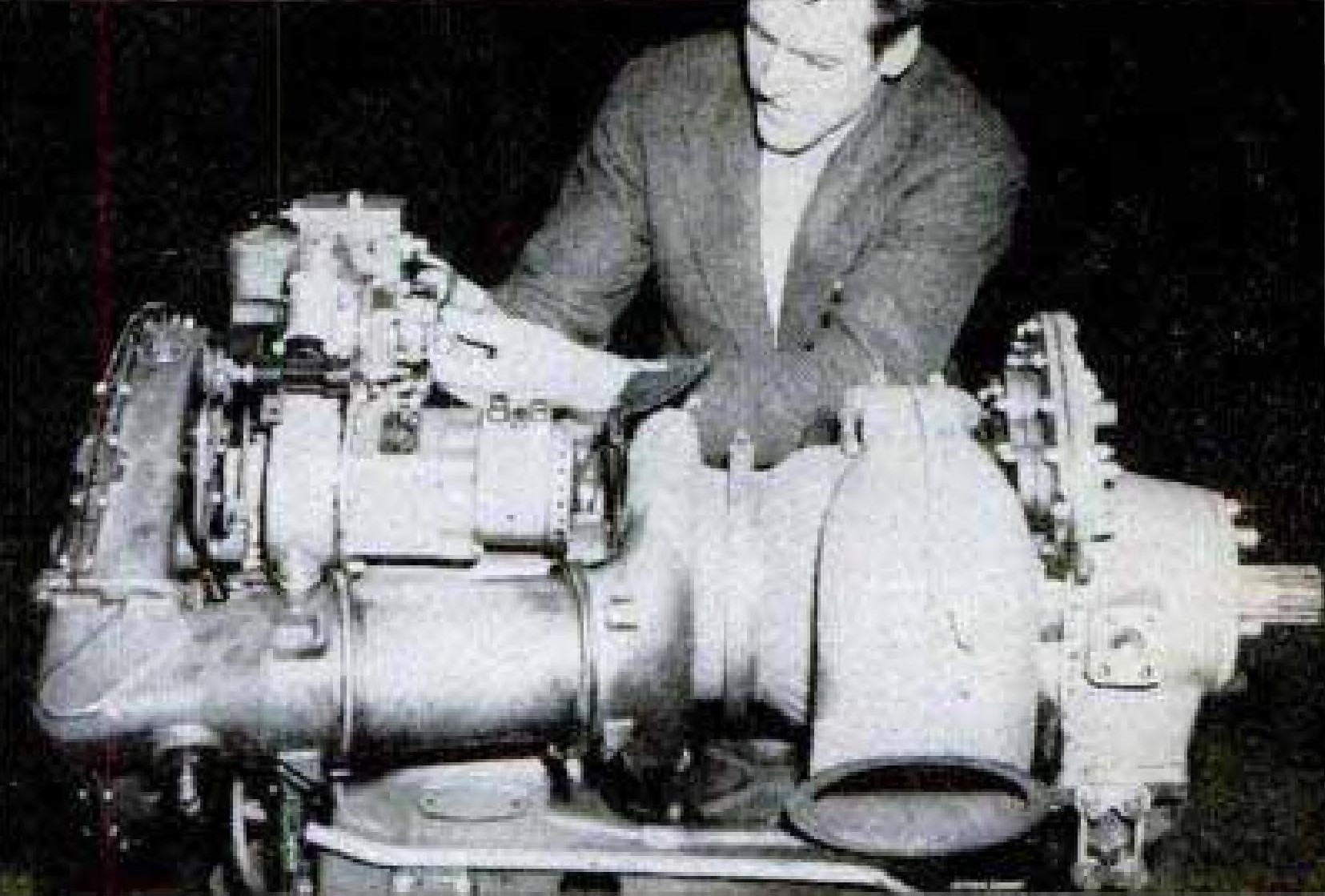
Here’s how Popular Mechanics described the engine in August 1953:
With 175 horsepower in “pony harness” the Boeing gas turbine engine is only 40 inches long, 23 inches wide, and 22 inches high, occupying less than 13 percent of the space required by a diesel truck engine. Weighing 200 pounds (plus about 60 pounds of accessories), it is 2500 to 3000 pounds lighter than present diesels of equal output. While the average diesel engine has 1400 parts and the average automobile engine 890, the gas-turbine engine has 400. Although normally operated with diesel oil, it will burn high or low-octane gasoline. kerosene, stove oil or jet fuel.
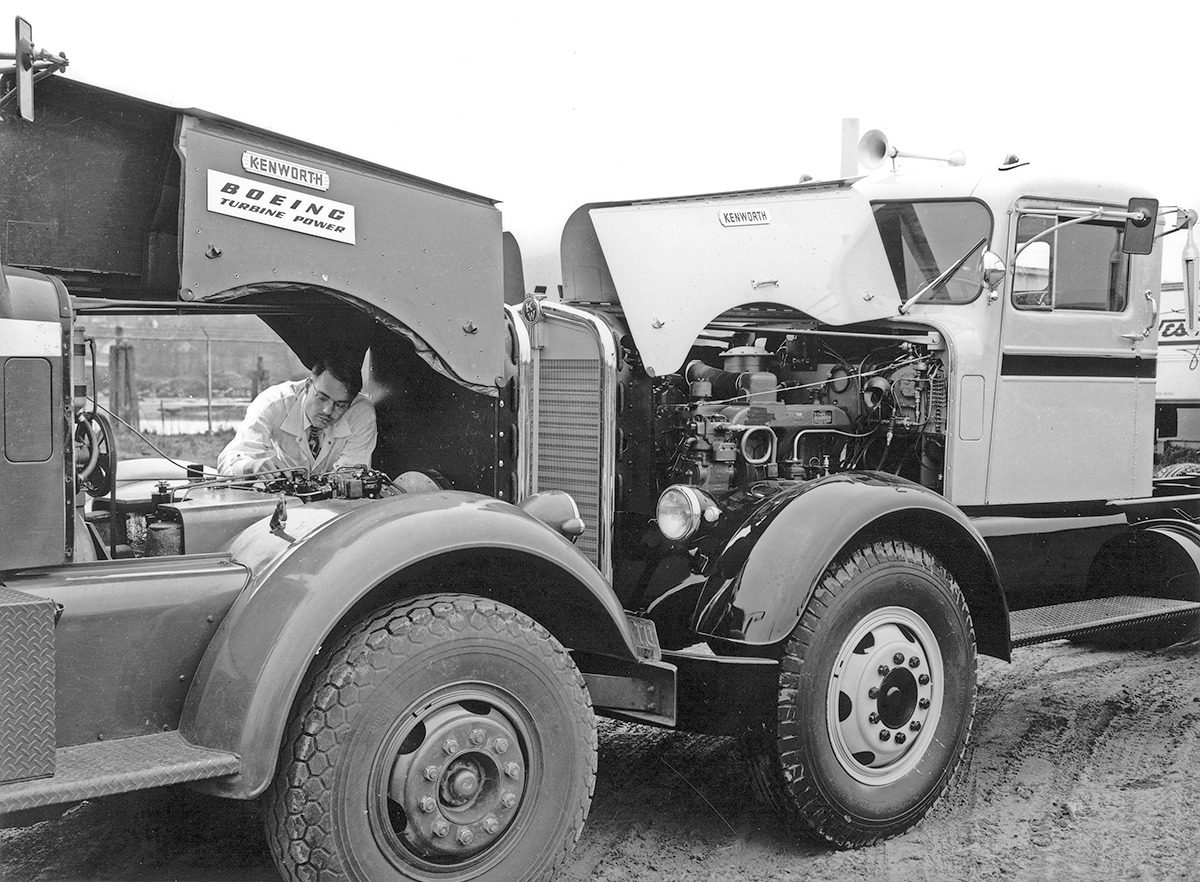
Lloyd E. Hull, one of the engineers involved in the project, described the engine’s application in a semi-tractor:
“You have to think of this engine in two stages,” said Hull. “In the first stage, a centrifugal compressor rotates at a maximum speed of 36,000 revolutions per minute. Sucks air like a vacuum cleaner, then compresses it to three times normal atmospheric pressure and delivers it to the burners. As fuel is fed into the burners, the temperature is raised to a maximum of 1500 degrees Fahrenheit. The hot gas then passes through the first-stage turbine wheel. This wheel extracts sufficient power from the gas stream to drive the compressor which is on the same shaft.
In the second stage, the gas stream passes through another turbine, which is not on the same shaft as the first-stage turbine wheel. The second-stage or power turbine wheel operates at 25,000 revolutions per minute. This is reduced in an 11:1 reduction gear to drive the truck. The system is really simple.”
On paper, this engine was almost the holy grail. It made nearly one horsepower per pound and took up less than 13 percent of the space of a diesel.
Unlike Any Other Truck At The Time
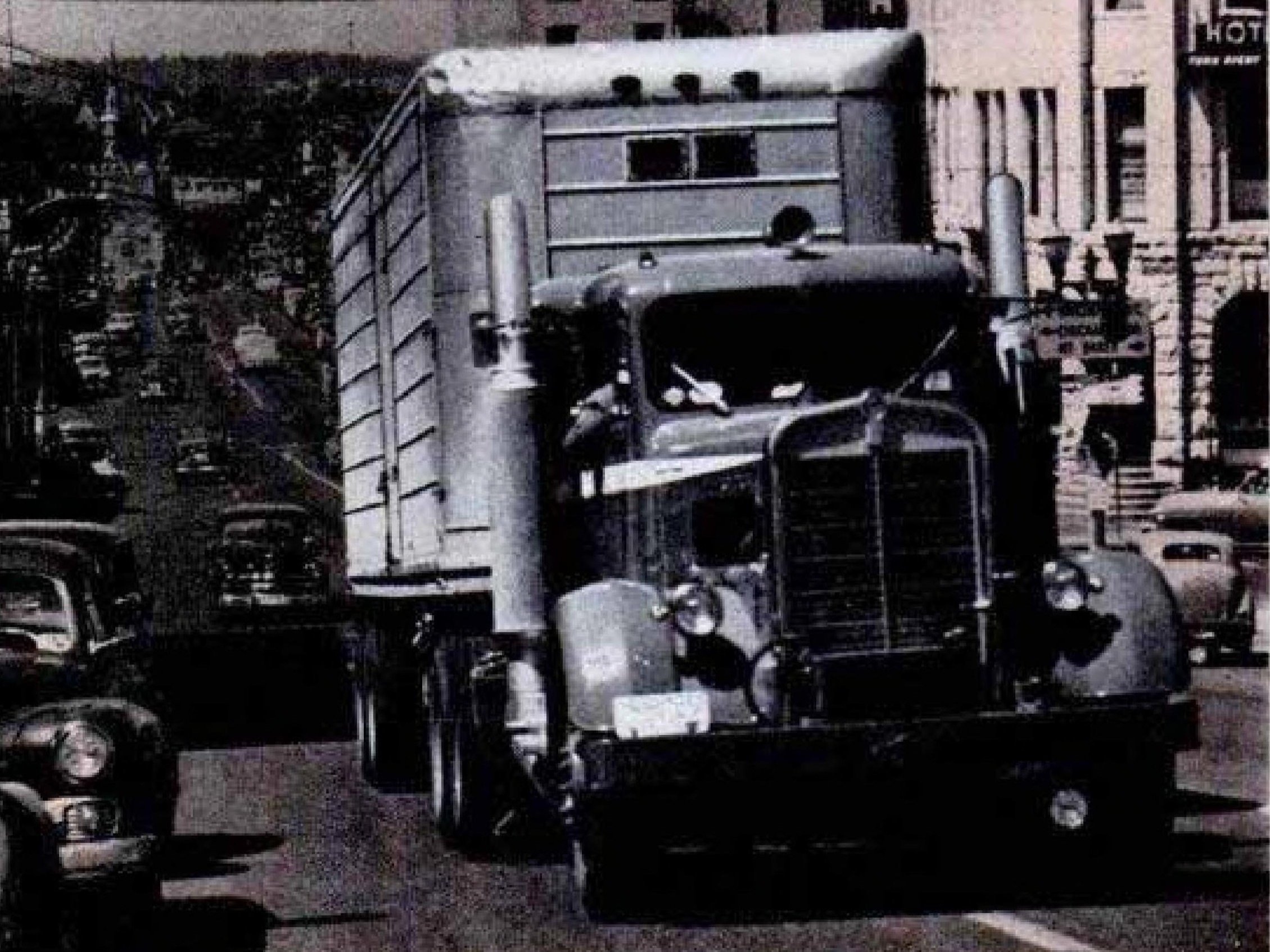
Boeing and Kenworth chose West Coast Fast Freight, Inc. as their testing partner, and trucker John Kelly had the privilege of driving the first and only gas turbine semi-tractor in service. Reportedly, wherever he stopped, the truck gathered crowds, and other truckers just had to know if that turbine was living up to its promise. Kelly was the perfect man for the job, as he had enjoyed both a long 16-year career in trucking and was also a World War II pilot who expertly avoided Japanese fighter aircraft in dozens of missions.
When interviewed by Popular Mechanics, Kelly put on quite the show when just starting the truck. From Popular Mechanics:
With 68,000 pounds of gross weight to be moved, Kelly pushed the starter button. As the fuel-pump pressure climbed quickly to 100 pounds per square inch, he opened the engine-control valve linked to the fuel Valve. The engine fired.
A warm-up period is not necessary with the turbine, but Kelly, from long habit, let the motor idle a moment. From the two huge exhaust stacks on opposite sides of the cab came a low, even roar, like wind rushing through a cave. Mingled with this sound was a high-pitched whistle from the reduction gears. Like a singing teakettle; not loud, but steady.
“Should have heard the whistle before a silencer was put on,” grinned Kelly. “You could hear it four miles away. Eventually, the researchers will probably eliminate the whistle entirely. But it doesn’t bother me. I really don’t hear it — most of the time.”

Kelly went on to say that the engine was so smooth that you didn’t feel it. This was great for reducing fatigue, as both noise and vibration can wear out a trucker on a long day. Kelly was also impressed with the acceleration, commenting that while a diesel truck might need 15 gears, the turbine truck had only six, and you really only used four of them.
When Popular Mechanics rode in his Kelly’s cab, he even pulled off a stunt where he stopped the truck dead on a hill, put it in second gear, and then pulled away. Kelly bragged that he wouldn’t have been able to do that in a fully-loaded diesel truck without starting in first and then shifting multiple times. If you were reading science magazines back then, you had to think turbines were the future. Everything said thus far sounds awesome!
The Turbine Was Hot And Thirsty
It was in that same article that some cracks in the turbine started to show. One of them was that 175 HP wasn’t even near the most powerful for a truck back then. The article described that more than one truck passed the turbine rig while on a mountain climb. Kelly shrugged it off, saying that Boeing was working on a more powerful version of the turbine.

The other problem was that the Boeing turbine ran really hot all the time. The turbine was at 900 degrees to 1,200 degrees Fahrenheit during normal cruising speeds, and sometimes climbed as high as 1,500 degrees during acceleration and hill climbs.
Boeing recognized that heat was a huge issue, and one that its engineers had spent years trying to fix. The aircraft manufacturer said that the turbine blades were made out of cobalt, nickel, tungsten, and chromium. This was important because, per Boeing, these materials could withstand only so much heat. The engine was already blazing hot as it is, and more power was not really possible without melting the engine down.
In fact, one of the issues caused by the insane heat was that the truck’s turbines cooked themselves to death, which meant that they had to be replaced more often than comparable diesels. Boeing’s response to that was saying that it would take four men 18 hours to replace a diesel engine, but a Boeing turbine could be replaced in four hours by only two men. I’m not entirely sure that’s still a positive since it wasn’t like a trucking company would have gotten replacement engines for free.

The biggest problem with the Boeing-Kenworth turbine truck wasn’t its lower power or the fact that the engine was a brick of heat, but the fact that it was hilariously terrible on fuel economy. The average big rig of the 1950s got 5 mpg. The turbine truck? It got one mpg. That’s not a typo; it burned a gallon every single mile.
To its credit, Boeing recognized that the abysmal fuel economy was a big problem. This is especially the case in trucking, where a truck that might get only 2 mpg more than average might be heralded as a genius idea. In Boeing’s case, it somehow made a truck that was more expensive in every possible metric, which is impressive. Boeing said that its scientists were actively looking for other metals it could use to make more powerful engines that offered better fuel economy.
The hits kept on coming for West Coast Fast Freight and the turbine Kenworth. As Hemmings writes, the trucking company’s Seattle to Los Angeles trip would end up taking four or five hours longer than usual because the truck was so slow. On top of that, the piping-hot exhaust blasted from the turbine at incredible speed, and the turbine had a knack for killing clutches when it wasn’t tearing itself apart. Kenworth and West Coast Fast Freight gave the project a few years and canned it. Sure, the Boeing turbine was buttery smooth and weighed only 200 pounds compared to the 2,700 pounds of a diesel, but the advantages were few. Kenworth says it canned the project on its end based on the abhorrent fuel economy alone.
Maybe Farming Or Firefighting?
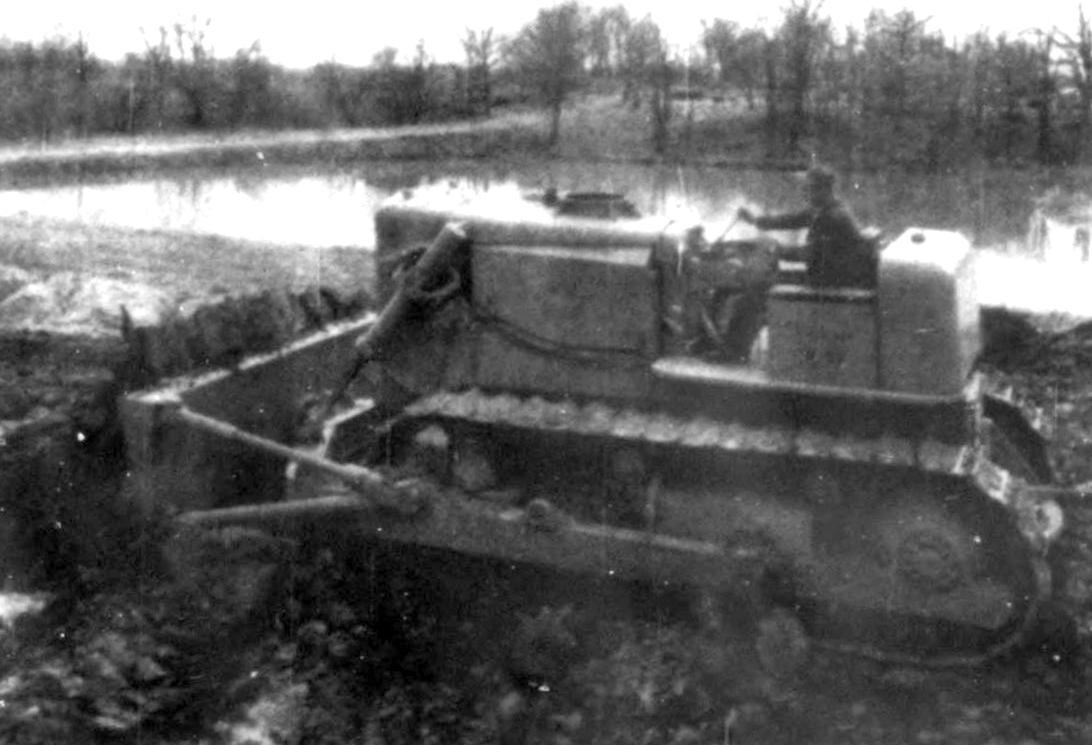
But Boeing didn’t give up, and figured that maybe if a turbine couldn’t work in trucking, maybe it could revolutionize farming or fire engines. In 1958, Boeing sent a Model 502-10C turbine to live inside an Allis-Chalmers P-91 crawler tractor. By now, Boeing’s turbine was making 240 shaft horsepower, but it had also gained weight to 320 pounds. The engine also failed to catch on in farming for similar reasons why it didn’t work out with Kenworth.
In 1961, Popular Science reported, Boeing gave it yet another try, sending two Model 502s to American La France, who fitted them to a pair of fire engines and put them into service in San Francisco. By now, Boeing’s engineers thought they had finally created the holy grail. The Model 502, at least as it was applied to the two fire trucks, made 330 HP and weighed 325 pounds. Finally, the engineers achieved a true one horsepower per pound of weight. The engine was still small at only 41.5 inches long, too.

The Turbo Chief, as it was called, out-pumped all of San Francisco’s diesel pumpers and demonstrated no issues climbing the 20.2-percent grades of San Francisco’s streets. Finally, Boeing fixed the power issues.
However, even San Francisco had to admit that the Turbo Chiefs weren’t perfect. As Hemmings wrote in a different article, the engines were $10,000 more (or about a third more) to purchase than an equivalent gasoline engine, and the turbines got approximately half of the fuel economy. Mind you, I’m talking about half of the fuel economy of a gas engine here, so we’re talking about really awful fuel economy. Consider that a fire engine might get up to 5 mpg, and at times will get 1 mpg. Slicing that in half is shocking.
However, San Francisco figured the money would even out in the end because diesel and kerosene were cheaper than gasoline and because Boeing promised that the turbines would be more reliable than reciprocating engines. As it turned out, Boeing’s promise didn’t work out. Whenever something broke, Boeing had to fly an engineer out to San Francisco to fix it, and parts were expensive. When the fuel control governor failed in one of the turbines in either 1966 or 1967, which would have cost $3,000 to replace, San Francisco went right back to reciprocating engines.
Terrible, But Awesome
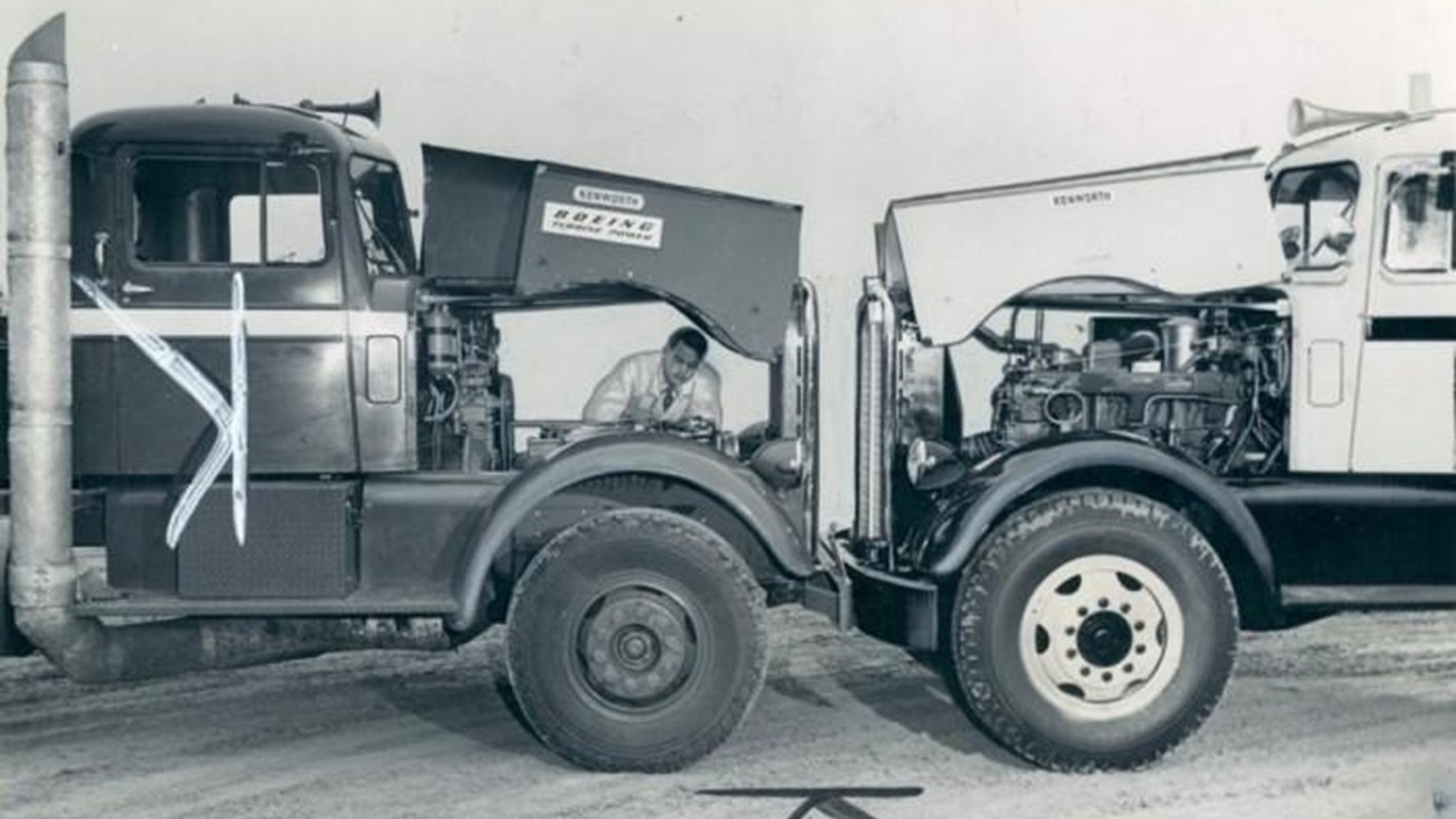
Ultimately, Boeing’s bid to revolutionize trucking, farming, and firefighting had failed spectacularly. Racer Jack Zink even tried to repurpose a Model 502 from a Kenworth truck to turn it into a rear-engine Indy 500 car, but the car failed as proper gearing could not be found.
This is not to say that the Model 502 was a total failure. The Model 502 was the propulsion of the world’s first gas turbine-powered helicopter and the world’s first turboprop light airplane. It seemed that the Model 502 worked as an aviation engine, just not as a truck engine.
Still, I get why it was done. The promises of the turbine were too hard to ignore. How could Boeing and Kenworth not give it a try? It’s also easy to see GM, Ford, International, and others gave it a try, too. While turbines might have sucked as truck engines, it’s awesome that they existed in the first place. At least for a few years, there were trucks darting up and down the West Coast with 1,500-degree tiny engines that got only 1 mpg.
Top Graphics images: Boeing-Kenworth/NASM)







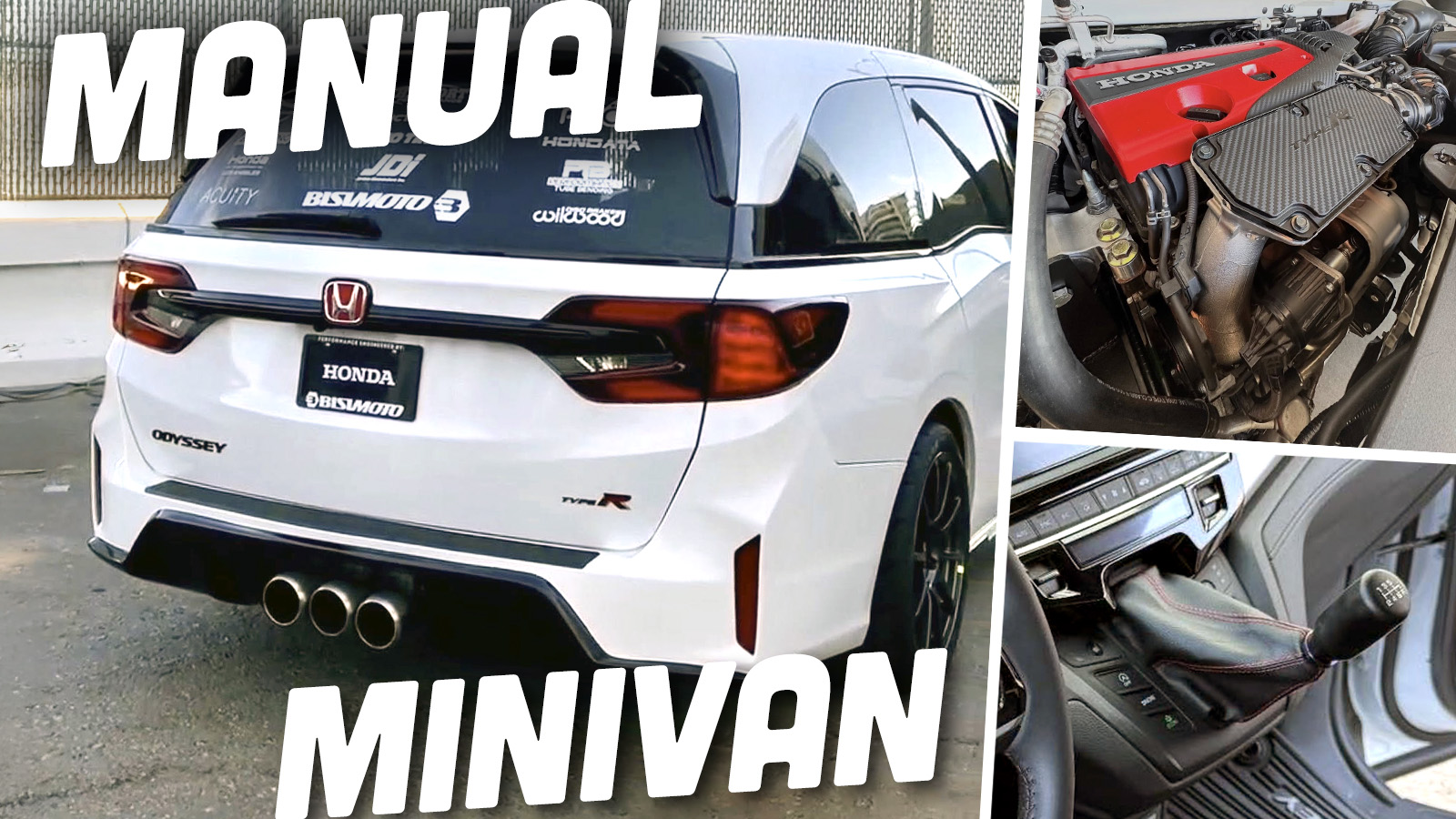
Turbines almost worked for racing too at Indy 500 in various cars and also in the Howmet Turbine endurance racer. There’s probably many more in other motorsports, but those are what stuck in my head.
The Abrams tank uses a turbine engine. When I was hunting at Fort Hunter Liggett I drove by one that was running, just an absolutely crazy sound from a tank.
Even then, piston engines were just too well-developed to beat. It happened again with the Wankel.
Is it happening again with EVs?
For a lot of trucking EV drivetrains make a ton of sense, they’re almost always better off with ICE range extenders, but the BEV drivetrain itself is hard to beat.
I don’t really see why it would. For long distance purposes sure, BEVs still have many drawbacks. When it comes to local commuting though, we can fairly easily produce cheaper batteries now and the electric motor is famously reliable.
I’d much rather daily a Leaf that needs zero maintenance beyond tires and occasional bearing lubrication instead of slowly killing an internal combustion engine by only driving it fifteen to twenty miles a day in stop-start traffic. If you’re charging at home and not driving very far regularly that use case is by far worse for an ICE which won’t come up to operating temp leading to oiling problems and the like.